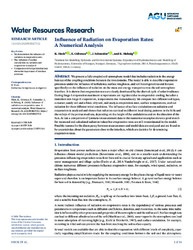Influence of Radiation on Evaporation Rates: A Numerical Analysis
DOI: https://doi.org/10.1029/2020WR027332
Persistent URL: http://resolver.sub.uni-goettingen.de/purl?gldocs-11858/8481
Persistent URL: http://resolver.sub.uni-goettingen.de/purl?gldocs-11858/8481
Heck, K.; Coltman, E.; Schneider, J.; Helmig, R., 2020: Influence of Radiation on Evaporation Rates: A Numerical Analysis. In: Water Resources Research, Band 56, 10, DOI: 10.1029/2020WR027332.
 |
Dokument öffnen: |
We present a fully coupled soil‐atmosphere model that includes radiation in the energy balance of the coupling conditions between the two domains. The model is able to describe evaporation processes under the influence of turbulence, surface roughness, and soil heterogeneities and focuses specifically on the influence of radiation on the mass and energy transport across the soil‐atmosphere interface. It is shown that evaporation rates are clearly dominated by the diurnal cycle of solar irradiance. During Stage‐I evaporation maximum temperatures are regulated due to evaporative cooling, but after a transition into Stage‐II evaporation, temperatures rise tremendously. We compare two different soil types, a coarser, sandy soil and a finer, silty soil, and analyze evaporation rates, surface temperatures, and net radiation for three different wind conditions. The influence of surface undulations on radiation and evaporation is analyzed and shows that radiation can lead to different local drying patterns in the hills and the valleys of the porous medium, depending on the height of the undulations and on the direction of the Sun. At last a comparison of lysimeter measurement data to the numerical examples shows a good match for measured and calculated radiation values but evaporation rates are still overestimated in the model. Possible reasons for the discrepancy between measurement and model data are analyzed and are found to be uncertainties about the parameters close to the interface, which are decisive for determining evaporation rates. Key Points:
We demonstrate the influence of radiation on evaporation rates.
The influence of surface undulations on radiation and evaporation is analyzed.
Comparison with experimental data shows the importance of interface processes.
Statistik:
ZugriffsstatistikSammlung:
This is an open access article under the terms of the Creative Commons Attribution License, which permits use, distribution and reproduction in any medium, provided the original work is properly cited.

